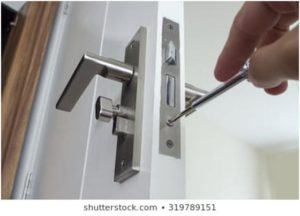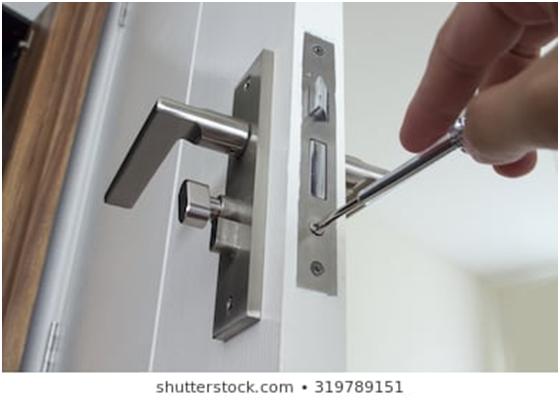You have a Yale lock without a latch and your door suddenly seems totally useless. Don’t give up just yet. There are ways to secure the door even when the there is no latch on the lock.
I removed my faulty latch assembly from my bathroom door expecting to have a new one delivered the same day. Three days later, it still has not arrived. How can I lock the door from the inside? It is uncomfortable to use the bathroom with the door only partially closed.
Image courtesy of Pixabay

Purpose of the Latch
The latch bolt is the angle-edged part of a lockset which is used to keep a door closed. A latch bolt is loaded with a spring which enables it to retract into the face plate when the knob is turned to open the door. When the door knob is released, the spring allows the latch bolt to extend out of the face plate. When the door is closed, the latch presses against the strike plate and retracts enough to allow the door to close. The latch then extends fully into its space in the door frame and clicks into position.
When a lock doesn’t have a latch, the door cannot be closed. It will easily fling open or closed with wind or even a light draught in the house. If your front door doesn’t have a latch, your security is greatly compromised. If it’s your bedroom or bathroom door, you will have no privacy.
How to Secure a Door without a Latch
Two common instances when you would find yourself with a Yale lock without a latch is if you have had the latch assembly removed and are waiting for a replacement. Another instance is when your Yale lock latch is stuck in a retracted position. Although the latch is present the lock is as good as one without a latch.
Here are 2 easy and effective ways to secure your door without a latch.
Use a Dinner Fork
You will need a metallic fork, a pair of pliers, a marker and a rubber band.
- Place the fork in the latch hole and mark a line on the fork prongs to indicate the exact depth of the latch hole
- Use the pliers to bend the fork prongs along the marked line until you achieve a 90 degree bend on all prongs
- Use the pliers to break off the fork handle
- Insert the bent prongs into the latch hole and hold the rest of the fork on the inside
- Shut the door
- Insert the handle through any of the fork slots to lock the door
- Use the rubber band to prevent the handle from falling off
Use a Door Jammer
A door jammeris a portable security device which is installed by slipping a flat pane under a door and a firm hinge leg is secured onto the floor. It works by converting horizontal force (exerted when someone on the outside attempts to open the door) into horizontal force used to maintain the jammer firmly on the floor. This increases the jammer’s grip. Door jammers are popular because they can be used on any type of floor, regardless of whether it is flat or inclined. An adjustable foot at the end of the hinge leg ensures the jammer is firmly secured. A foot pad below the adjustable foot allows it to grip on surfaces like hard wood floors, linoleum and even carpets.
Improvised Door Jammers
If you cannot get your hands on a door jammer, there are ways to improvise one.
Wooden or rubber wedges: Jam the sharp edge of a wooden or rubber wedgeunder the door. This prevents the door from opening because the door is forced against the thick part of the wedge.
Chair under door knob: This is an age-old, temporary method of keeping a door locked from the inside. Jam the shoulder of a chair under the door knob. Allow the chair to lean back with its front legs suspended in the air.
Shoes: it is best to use a shoe with a sharp tip. Jam the tip of the shoe under the door and push it as far as possible.
Conclusion
It is clear that a latch is a small but very integral part of any lock. Without it your door could seem somewhat useless. Regardless of how you ended up with a Yale lock without a latch, improvising is the way to go. Whether you have access to a store- boughtdoor jammeror you have to make use of locally availablematerials at home, all is not lost. You can still keep your house secure and keep internal doors closed when you need to enjoy some privacy.
FAQ
My Yale door latch is not retracting far enough when I turn the knob. It has to be wiggled a bit to get it to retract fully. What causes this?
This is probably caused by a buildup of dirt in the components which enable the latch to retract ad extend.
Is a deadlocking Yale night latch any better than a standard Yale night latch?
The two operate in the same way except that you can deadlock the bolt from the outside using a key. It is more secure because the latch cannot be opened using a card (card slipping)
My Yale lock snib switch moves up and down but does not hold the latch in a retracted or extended position. Can it be fixed?
Take the lock off the door and open it up. When you open the back plate, the back of the snib will be visible. You will notice a grooved slot. Make sure this part sits on the spring.
Can I use WD-40 on my Yale lock in the winter?
WD-40’s freezing point is -50 degrees F. It is safe to use as long as temperatures are above this.

